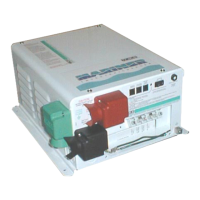,03257$176$)(7<,16758&7,216
&RS\ULJKW7UDFH(QJLQHHULQJ&R,QF 7HOHSKRQH 3DUW1XPEHU
WK
6WUHHW1( )D[ 2FWREHU
$UOLQJWRQ:$86$ ZZZWUDFHHQJLQHHULQJFRP 3DJH
,03257 $176$)(7<,16758&7,216
SAVE THESE INSTRUCTIONS
This manual contains important safety and operating instructions as prescribed by UL specifications
for inverters used in marine applications. This manual covers inverters and inverter/chargers models:
M2012, M2512, and M3012 Mariner inverter/chargers. The entire Mariner Series of inverters is ETL
listed to the general UL specification #458.
*HQHUDO3UHFDXWLRQV
1.
Before using the inverter/charger, read all instructions and cautionary markings on (1) the
inverter/charger, (2) the batteries, and (3) all appropriate sections of this instruction manual.
2.
CAUTION - To reduce risk of injury, charge only deep-cycle lead acid, lead antimony, lead
calcium, gel cell, or absorbed mat type rechargeable batteries. Other types of batteries may
burst, causing personal injury and damage.
3.
Do not expose inverter/charger to rain, snow or liquids of any type. The inverter is designed
for interior mounting only. Protect the inverter from splashing when used in marine
applications.
4.
Do not disassemble the inverter/charger; take it to a qualified Trace Engineering Service
Center when service or repair is required. Incorrect re-assembly may result in a risk of
electric shock or fire.
5.
To reduce risk of electric shock, disconnect all wiring before attempting any maintenance or
cleaning. Turning off the inverter will not reduce this risk.
6.
WARNING - RISK OF EXPLOSIVE GASES
WORKING IN VICINITY OF A LEAD ACID BATTERY MAY BE DANGEROUS.
BATTERIES GENERATE EXPLOSIVE GASES DURING NORMAL OPERATION. FOR
THIS REASON, IT IS OF UTMOST IMPORTANCE THAT EACH TIME BEFORE
SERVICING EQUIPMENT IN THE VINCINTITY OF THE BATTERY, YOU READ THIS
MANUAL AND FOLLOW THE INSTRUCTIONS EXACTLY.
Provide ventilation to outdoors from the battery compartment. The battery enclosure should
be designed to prevent accumulation and concentration of hydrogen gas in “pockets” at the
top of the compartment. Vent the battery compartment from the highest point. A sloped lid
can also be used to direct the flow to the vent opening location.
To reduce the risk of battery explosion, follow these instructions and those published by
battery manufacturer and any manufacturer of any equipment you intend to use in the
vicinity of batteries. Review cautionary markings on these products and all other products
being used.

